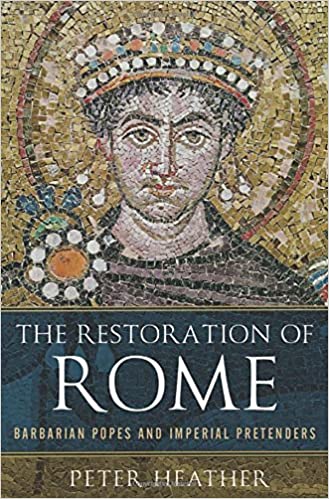|
The Restoration of Rome: Barbarian Popes and Imperial Pretenders
By Peter Heather Published in March 2014 488 Pages Thibault’s Score: 4/5 The Restoration of Rome is a history of the numerous attempts at restoring the Roman Empire during the early Middle Ages. It is a fascinating and well written book, although for people who are just getting into medieval history might not be the best starting point. The book covers four major attempts at restoring the roman empire during the period 500 AD to 1000 AD. During the waning years of Western Roman imperial authority, a barbarian general Odoacer stages a coup. He announces that a Western Roman emperor is no longer needed, sending his Imperial robes back to Constantinople. This marks the official end of the Roman Empire. In the immediate aftermath, the Eastern Empire sends Gothic general Theodoric to depose Odoacer. Theodoric’s regime marks a partial restoration of the earlier Roman Republic. The Senate once again becomes one of the most prominent institutions in Italy. Furthermore, many of the neighboring barbarian tribes who have settled in former Roman territory submit to his authority. Under his rule, Roman culture enjoys a brief second flourishing - authors like Cassius Dio and Boethius reinforcing traditional Roman values. Finally, his reign sees the birth of the institution that would slowly evolve to become the Papacy/ Theodoric’s brief renaissance comes to an end when Eastern Roman emperor Justinian decides to invade Italy. While Justinian is often hailed by modern pop culture as a great “restorer” of Rome, in reality his regime is authoritarian and despotic. His wars decimate Italy, marking the final death blow to Roman civilization. Worst of all, his reconquests prove fruitless. In many ways, Justinian’s death marks a good alternative end date for the fall of the Western Roman Empire. In the century after Justinian’s reign of terror, barbarian chiefs in modern day France and Germany begin consolidating their power. Because there has now been no Roman empire in centuries they decide to legitimate their authority. Charlemagne crosses the alps, destroying the Lombard barbarian kingdom which had appeared in the wake of Justinian. There, he “liberates” the papacy, and has himself crowned Western Roman emperor. He even attempts to marry the Byzantine empress in an attempt to reunify the Eastern and Western halves of the empire. Some of his successors, like Otto, would also feebly attempt to crown themselves Roman emperor, although by then it would be reduced to the status of a meaningless title. Ultimately, the institution that would durably replace the Western Roman empire would be the Catholic church. Heather argues that it is in fact “barbarian popes” who would restore the Roman tradition of written law, once and for all superseding the need to restore the Western Roman empire. The Restoration of Rome is a must read for any intermediate researchers who want to learn about the early Middle Ages.
0 Comments
|
Thibault SerletMost of my articles are book reviews, but I also write about many other topics. Archives
December 2023
Categories |

 RSS Feed
RSS Feed